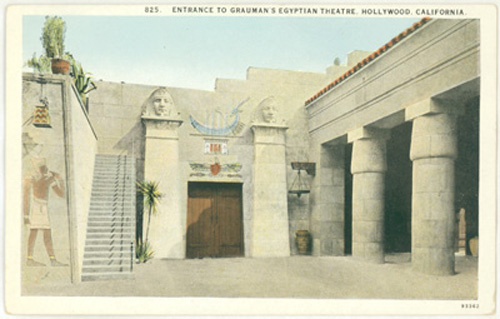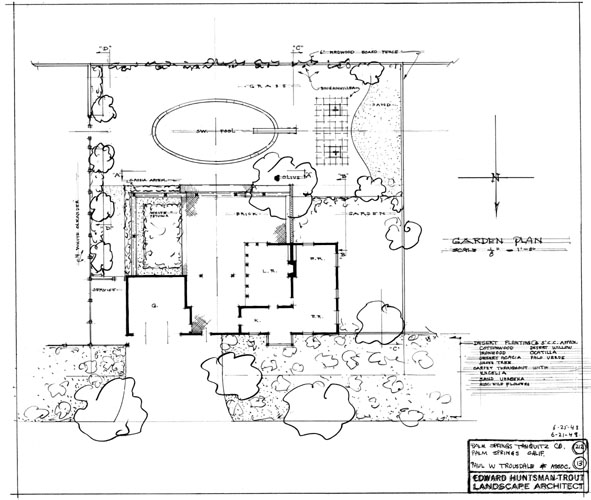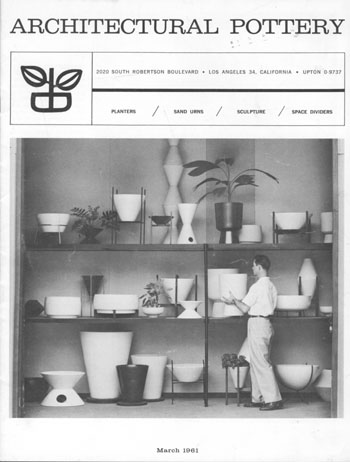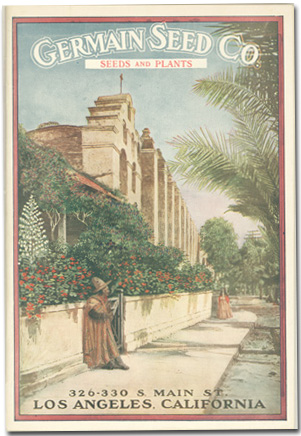
Holdings document the exploration of new materials, the indoor-outdoor lifestyle afforded by southern California's climate, and the connection of architecture with the growth of the region. The papers of A. Quincy Jones, Richard Neutra, and Lloyd Wright contain near-complete records of their work. The Max and Rita Lawrence papers document architectural pottery and other items associated with modern Los Angeles architecture, and drawings and photographs of S. Charles Lee the evolution of motion picture theater buildings. Papers of landscape architects include those of Ralph D. Cornell, Edward Huntsman-Trout, Florence Yoch, and Philip Chandler, and there are records of the American Institute of Landscape Architects.

Edward Huntsman - Trout, 1889 - . Loose leaf project daybook. Los Angeles, 1920s. In: Huntsman-Trout, Edward, 1889 - . Papers, 1916 - 1974. Collection 1186. Box 34 f.8
This item is among the only evidence that Huntsman-Trout contributed to the design of the first Hollywood movie palace, Sid Grauman's Egyptian Theatre (Meyer and Holder, architects, 1922), recently restored. Beatrice (Mrs. Edward) Huntsman-Trout was interviewed by the UCLA Oral History Program.
Western Publishing & Novelty Co. Entrance to Grauman's Egyptian Theatre, Hollywood, California [color postcard]. Los Angeles, 1930s? No. at head of title: 825; code: 93363. In: Collection of California postcards, 1890 - . Collection 1351. Box 18

Small mounted photographs in the Huntsman-Trout papers show his work at Grauman's. This postcard shows his plantings, although the main designs were on the west wall. These more elaborate designs and plantings are not visible from the perspective of the view on this card.
Edward Huntsman - Trout, 1889 - . Garden Plan. For Palm Springs Tahquitz Co., Paul W. Trousdale & Associates. 1948. Drawing. Pencil on paper, scanned from copy negative and reduced. Dates: 6 - 25 - 48 and 6 - 21 - 48. Collection 1186. Box 8 f.1

This plan is a prototype landscape plan for various small tract homes (later versions of California "bungalows") developed by Trousdale. A note on a drawing by Huntsman-Trout for movie director Thomas Ince's gardens (ca. 1923) says "moonlight garden," although no details seem to be recorded anywhere. Gardens designed to be viewed by strong moonlight were originated by the Moguls. This seems to be a version of such gardens, the plan calling for a bed of white petunias backed by cassia and topped with white oleander. The white would be bright against the silver gray green leaves, with sulfur yellow added when the cassia bloomed.

Julius Shulman. Grace Miller house, Palm Springs CA. 1939. Designed by Richard Neutra, 1937. Black and white photograph, scanned copy. In: Neutra, Richard Joseph, 1892 - 1970. Papers, 1925 - 1970. Collection 1179. Box 80
This house was yet another example of Neutra's fine site planning and landscape design, as well as architectural design. The modern materials contrast with and frame from within the desert and mountains surrounding. This is a less common view by photographer Shulman than others often reproduced. It shows the variety of desert plantings. Modern California architects pioneered the use of new materials but also worked within a larger California framework. This house stems from the idea of California bungalows, but is even smaller than those of the decades preceding it. While the late 1920s and 1930s were the peak of various historical revival architecture styles in southern California and garden design and plantings to complement them, designers and landscape architects began to use native California plants in less traditional plans. Neutra's planting list for this house shows his familiarity with the desert, as does that of Huntsman-Trout. These plants were frequently shown on postcards and are still today. Huntsman-Trout's drawing (above) notes "desert planting: cottonwood, ironwood, desert acacia, smoke tree, ocatill[o], palo verde ... ." Neutra's planting list was much the same. Dione (Mrs. Richard) Neutra was interviewed by the UCLA Oral History Program.
Ralph D. Cornell. Conspicuous California Plants, with Notes on their Garden Uses. Illustrations by the author. Drawings by Elizabeth Lewis. Pasadena, California: San Pasqual Press, 1938. SB 466 U7 C2c
Ralph Cornell was UCLA's first landscape architect working only for this campus. His original plans maintained the idea of a California landscape rather than bow to the revival architecture of the original buildings. His friend Theodore Payne was among the first of the California nursery persons to propagate native plants for gardens, as were Theodosia Burr Shepherd in Ventura and Kate Sessions, who often worked with architect Irving Gill, in San Diego and La Jolla. This book was published in Pasadena by Dorothy Bevis, who looked to a local rancho as the source for her firm's name. The press also published historian W.W. Robinson's Ranchos Become Cities (1939) and Lawrence Clark Powell's Robinson Jeffers: The Man and His Work (1940), based on his dissertation at the University of Dijon. Ralph Cornell was interviewed by the UCLA Oral History Program.
Stephen H. Willard, photographer? Varieties of Desert Vegetation [color postcard]. Palm Springs, no date [card sent and postmarked 1959]. Code: 9A - H1607. In: Collection of California postcards, 1890 - . Collection 1351. Box 14
This card appears to have been produced much earlier than postmarked. It could almost serve as an illustration for the planting lists of Neutra and Huntsman-Trout.

|
Architectural Pottery (Firm: Los Angeles, Calif.). Architectural
Pottery: Planters / Sand Urns / Sculpture / Space Dividers [catalog of products
available]. [Los Angeles]: March 1961. In: Architectural Pottery (Firm: Los
Angeles, Calif.). Records from Max and Rita Lawrence, ca. 1950 - 1994. Collection
1587. Box 4 f.18
Architectural Pottery was formed September 1950 to produce and distribute large-scaled ceramic planters of contemporary design. These and other architectural accessories were used extensively in post war modern California architecture. The firm later produced many of the accessories associated with 1960s and 1970s shopping centers and offices. Max Lawrence and distinguished alumna Rita (Mrs. Max) Lawrence were interviewed by the UCLA Oral History Program. |
 |
References |
References |  |

